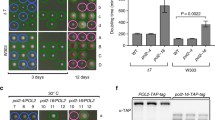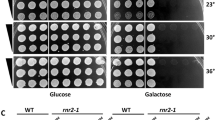Abstract
Thesuc22 + gene ofSchizosaccharomyces pombe encodes the small subunit of ribonucleotide reductase. Two transcripts that hybridise tosuc22 + have previously been described: a constitutive transcript of 1.5 kb, and a transcript of ∼1.9 kb that is induced when DNA replication is blocked by hydroxyurea. In this paper we show that both transcripts derive from thesuc22 + gene, are polyadenylated, and have transcription initiation sites separated by ∼550 nucleotides. The absence of translation initiation codons and predicted intron splice sites within this 550 nucleotide region suggests strongly that both transcripts encode the same protein. Under normal growth conditions, the largersuc22 + transcript is present at a very low level. This low level expression is periodic during the cell cycle, showing a pattern similar to that of other genes under regulation by MCB elements with a maximum in G1/S phase. Consistent with this, there are MCB elements upstream of the initiation site of the transcript. This pattern of expression contrasts with the continuous expression, at a much higher level, of the smallersuc22 + transcript. The largersuc22 + transcript is induced by exposure of cells to 4-nitroquinoline oxide (4-NQO), a UV-mimetic agent that causes DNA damage. The transcriptional response to 4-NQO is observed in cells previously arrested in G2 by acdc2 ts mutation, demonstrating that induction can occur outside S phase. We show that therad1 + gene, part of the mitotic checkpoint, is required for induction of the large transcript. Exposure of cells to heat shock also induces thesuc22 + large transcript: a consensus heat shock element has been identified upstream of the large transcript start site.
Similar content being viewed by others
References
Al-Khodairy F, Carr Am (1992) DNA repair mutants defining G2 checkpoint pathways inSchizosaccharomyces pombe. EMBO J 11:1343–1350
Alfa C, Fantes P, Hyams J, McLeod M, Warbrick E (1993) Experiments with fission yeast: a laboratory course manual. Cold Spring Harbor Laboratory Press, Cold Spring Harbor, New York
Amin J, Ananthan JA, Voellmy R (1988) Key features of heat shock regulatory elements. Mol Cell Biol 8:3761–3769
Björklund S, Skogman E, Thelander L (1992) An S-phase specific release from a transcriptional block regulates the expression of mouse ribonucleotide reductase R2 subunit. EMBO J 11:4953–4959
Caligiuri M, Beach D (1993) Sct1 functions in partnership with Cdc10 in a transcription complex that activates cell cycle START and inhibits differentiation. Cell 71:607–619
Carr AM (1995) DNA structure checkpoints in fission yeast. Semin Cell Biol 6:65–72
Elledge SJ, Davis RW (1990) Two genes differentially regulated in the cell cycle and by DNA-damaging agents encode alternative regulatory subunits of ribonucleotide reductase. Genes Dev 4:740–751
Elledge SJ, Zhou Z, Allen JB (1992) Ribonucleotide reductase-regulation, regulation, regulation. Trends Biochem Sci 17:119–123
Eriksson S, Sjoberg B-M (1989) Ribonucleotide reductase. In: Herve G (ed) Allosteric enzymes. CRC Press, Boca Raton, Florida, pp 189–215
Fernandez Sarabia M-J, McInerny C, Harris P, Gordon C, Fantes P (1993) The cell-cycle genescdc22 + andsuc22 + of the fission yeastSchizosaccharomyces pombe encode the large and small subunits of ribonucleotide reductase. Mol Gen Genet 238:241–251
Gallo G-J, Schuetz TJ, Kingston RE (1991) Regulation of heat shock factor inSchizosaccharomyces pombe more closely resembles regulation in mammals than inSaccharomyces cerevisiae. Mol Cell Biol 11:281–288
Gallo GJ, Prentice H, Kingston RE (1993) Heat shock factor is required for growth at normal temperatures. Mol Cell Biol 13:749–761
Gordon C, Fantes P (1986) Thecdc22 gene ofSchizosaccharomyces pombe encodes a cell cycle regulated transcript. EMBO J 5:2981–2986
Hartwell LH, Weinert TA (1989) Checkpoints: controls that ensure the order of cell cycle events. Science 246:629–634
Hofmann FX, Beach D (1994)cdt1 is an essential target of the Cdc10/Sct1 transcription factor: requirement for DNA replication and inhibition of mitosis. EMBO J 13:425–434
Johnston LH, Johnson AL (1995) The DNA repair genesRAD54 andUNG1 are cell-cycle-regulated in budding yeast but MCB promoter elements have no essential role in the DNA damage response. Nucleic Acids Res 23:2147–2152
Johnston LH, Lowndes NF (1992) Cell cycle control of DNA synthesis in budding yeast. Nucleic Acids Res 20:2403–2410
Kelly TJ, Martin GS, Forsburg SL, Stephen RJ, Russo A, Nurse P (1993) The fission yeastcdc18 + gene product couples S phase to START and mitosis. Cell 74:371–382
Koch C, Nasmyth K (1994) Cell cycle regulated transcription in yeast. Curr Opin Cell Biol 6:451–459
La Thangue NB (1994) DP and E2F proteins: components of a heterodimeric transcription factor implicated in cell cycle control. Curr Opin Cell Biol 6:443–450
Lee JK, Park EJ, Chung HK, Hong SH, Joe CO, Park SD (1994) Isolation of UV-inducible transcripts fromSchizosaccharomyces pombe. Biochem Biophys Res Commun 202:1113–1119
Lee KJ, Kim M, Choe J, Seong RH,Hong SH, Park SD (1995) Characterization ofuvi15 +, a stress-inducible gene fromSchizosaccharomyces pombe. Mol Gen Genet 246:663–670
Lindquist S, Craig EA (1988) The heat shock proteins. Annu Rev Genet 22:631–677
Lowndes NF, McInerny CJ, Johnson AL, Fantes PA, Johnson LH (1992) Control of DNA synthesis genes in fission yeast by the cell-cycle genecdc10 +. Nature 355:449–453
Lydall D, Weinert T (1995) Yeast checkpoint genes in DNA damage processing: implications for repair and arrest. Science 270:1488–1491
MacNeill SA, Creanor J, Nurse P (1991) Isolation, characterization and molecular cloning of new mutant alleles of the fission yeast p34cdc2+ protein-kinase gene-identification of temperature-sensitive G2-arresting alleles. Mol Gen Genet 229:109–118
McInerny CJ, Kersey PJ, Creanor J, Fantes PA (1995) Positive and negative roles for cdc10 in cell cycle gene expression. Nucleic Acids Res 23:4761–4768
Miyamoto M, Tanaka K, Okayama H (1994)res2 +, a new member of thecdc10 +/SWI4 family, controls the start of mitotic and meiotic cycles in fission yeast. EMBO J 13:1873–1880
Morimoto RI, Tissieres A, Geogopoulos C (1990) The stress response, functions of proteins, and perspectives. In: Morimoto RI, Tissieres A, Geogopoulos C (eds) Stress proteins in biology and medicine. Cold Spring Harbor Laboratory, Press, Cold Spring Harbor, NY, pp 1–36
Murray A (1995) The genetics of cell cycle checkpoints. Curr Opin Genet Dev 5:5–11
Nakagawa CW, Mutoh N, Hayashi Y (1995) Transcriptional regulation of catalase gene in the fission yeastSchizosaccharomyces pombe: molecular cloning of the catalase gene and Northern blot analyses of the transcript. J Biochem 118:109–116
Rowley R, Subramani S, Young PG (1992) Checkpoint controls inSchizosaccharomyces pombe-rad1 EMBO J 11:1335–1342
Saka Y, Fantes P, Sutani T, McInerny C, Creanor J, Yanagida M (1994) Fission yeast cut5 links nuclear chromatin and M-phase regulator in the replication checkpoint control. EMBO J 13:5319–5329
Sambrook J, Fritsch EF, Maniatis T (1989) Molecular cloning: a laboratory manual. Cold Spring Harbor Laboratory Press, Cold Spring Harbor, NY
Sheldrick KS, Carr AM (1993) Feedback controls and G2 checkpoints: fission yeast as a model system. BioEssays 15:775–782
Tanaka K, Okazaki K, Okazaki N, Ueda T, Sugiyama A, Nojima H, Okayama H (1992) A newcdc gene required for S-phase entry ofSchizosaccharomyces pombe encodes a protein similar to thecdc10 + andSWI4 gene products. EMBO J 11:4923–4932
Walworth N, Davey S, Beach D (1993) Fission yeastchk1 protein kinase links therad checkpoint pathway tocdc2. Nature 363:368–371
Weisman R, Creanor J, Fantes PA (1996) A multicopy suppressor of a cell cycle defect inS. pombe encodes a heat shock-inducible 40 kDa cyclophilin-like protein. EMBO J 15:447–456
Xiao H, Lis TJ (1988) Germline elements used to defined key features of heat shock elements. Science. 239:1139–1142
Zhang MQ, Marr TG (1994) Fission yeast gene structure and recognition. Nucleic Acids Res 22:1750–1759
Zhou Z, Elledge SJ (1993)DUN1 encodes a protein-kinase that controls the DNA damage response in yeast. Cell 75:1119–1127
Zhu Y, Takeda T, Nasmyth K, Jones N (1994)Pct1 +, which encodes a new DNA-binding partner of p85cdc10, is required for meiosis in the fission yeast Schizosaccharomyces pombe. Genes Dev 8:885–898
Author information
Authors and Affiliations
Additional information
Communicated by J. B. Kilbey
Rights and permissions
About this article
Cite this article
Harris, P., Kersey, P.J., McInerny, C.J. et al. Cell cycle, DNA damage and heat shock regulatesuc22 + expression in fission yeast. Molec. Gen. Genet. 252, 284–291 (1996). https://doi.org/10.1007/BF02173774
Received:
Accepted:
Issue Date:
DOI: https://doi.org/10.1007/BF02173774




